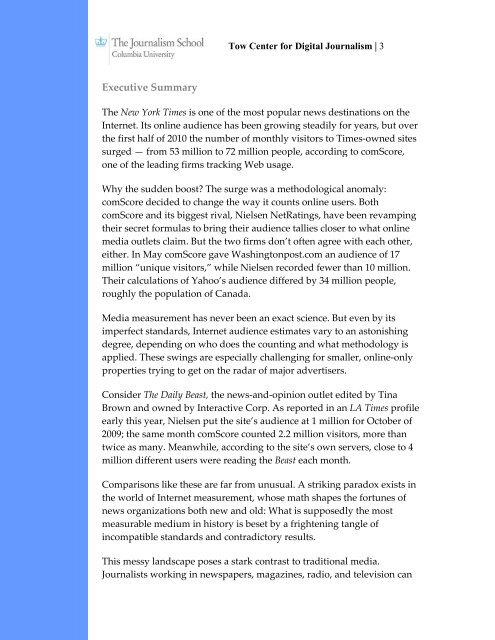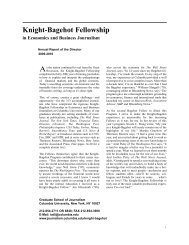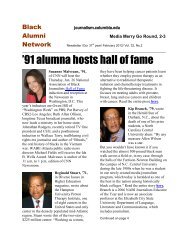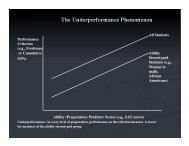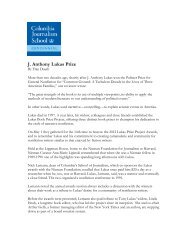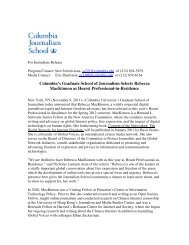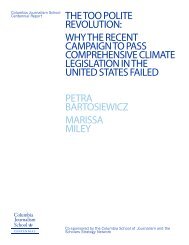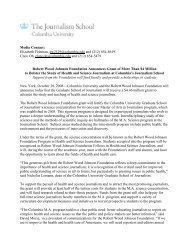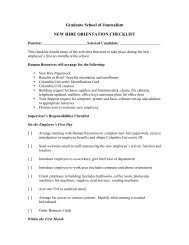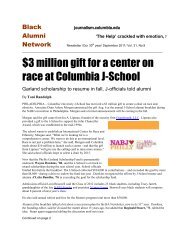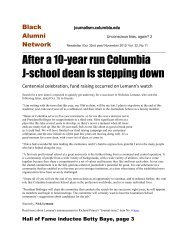Click here for executive summary
Click here for executive summary
Click here for executive summary
You also want an ePaper? Increase the reach of your titles
YUMPU automatically turns print PDFs into web optimized ePapers that Google loves.
Tow Center <strong>for</strong> Digital Journalism | 3<br />
Executive Summary<br />
The New York Times is one of the most popular news destinations on the<br />
Internet. Its online audience has been growing steadily <strong>for</strong> years, but over<br />
the first half of 2010 the number of monthly visitors to Times‐owned sites<br />
surged — from 53 million to 72 million people, according to comScore,<br />
one of the leading firms tracking Web usage.<br />
Why the sudden boost? The surge was a methodological anomaly:<br />
comScore decided to change the way it counts online users. Both<br />
comScore and its biggest rival, Nielsen NetRatings, have been revamping<br />
their secret <strong>for</strong>mulas to bring their audience tallies closer to what online<br />
media outlets claim. But the two firms don’t often agree with each other,<br />
either. In May comScore gave Washingtonpost.com an audience of 17<br />
million “unique visitors,” while Nielsen recorded fewer than 10 million.<br />
Their calculations of Yahoo’s audience differed by 34 million people,<br />
roughly the population of Canada.<br />
Media measurement has never been an exact science. But even by its<br />
imperfect standards, Internet audience estimates vary to an astonishing<br />
degree, depending on who does the counting and what methodology is<br />
applied. These swings are especially challenging <strong>for</strong> smaller, online‐only<br />
properties trying to get on the radar of major advertisers.<br />
Consider The Daily Beast, the news‐and‐opinion outlet edited by Tina<br />
Brown and owned by Interactive Corp. As reported in an LA Times profile<br />
early this year, Nielsen put the site’s audience at 1 million <strong>for</strong> October of<br />
2009; the same month comScore counted 2.2 million visitors, more than<br />
twice as many. Meanwhile, according to the site’s own servers, close to 4<br />
million different users were reading the Beast each month.<br />
Comparisons like these are far from unusual. A striking paradox exists in<br />
the world of Internet measurement, whose math shapes the <strong>for</strong>tunes of<br />
news organizations both new and old: What is supposedly the most<br />
measurable medium in history is beset by a frightening tangle of<br />
incompatible standards and contradictory results.<br />
This messy landscape poses a stark contrast to traditional media.<br />
Journalists working in newspapers, magazines, radio, and television can
Tow Center <strong>for</strong> Digital Journalism | 4<br />
rely on a dominant “currency” (though always an imperfect one) to<br />
measure audiences, close advertising deals, and assess the competition.<br />
This report explores the industry of Internet measurement and its impact<br />
on news organizations working online. It investigates this landscape<br />
through a combination of documentary research and interviews with<br />
measurement companies, trade groups, advertising agencies, media<br />
scholars, and journalists from national newspapers, regional papers, and<br />
online‐only news ventures. Principal findings include the following:<br />
* Major online news outlets routinely subscribe to multiple, incompatible,<br />
and quite expensive sources of audience measurement, picking and<br />
choosing data to tell a compelling story to advertisers. Smaller ventures<br />
rely mainly on Google Analytics.<br />
* Uncertainty about audience measurement hinders online ad spending,<br />
with buyers and sellers of media favoring incompatible metrics. (A 2009<br />
study by McKinsey & Co., commissioned by the Internet Advertising<br />
Bureau, echoed this finding.)<br />
* Uncertainty about audience measurement impedes editorial decisionmaking,<br />
with editors unsure of which readers favor what coverage.<br />
Editors still choose among costly projects by instinct; as one reported,<br />
“You have more data, but itʹs conflicting.”<br />
* The media‐planning dynamic is inverted online: marketers allocate more<br />
resources to optimizing campaigns as they run, rather than to planning<br />
them be<strong>for</strong>ehand. Even brand advertisers have adopted the thinking of<br />
the less‐fashionable world of direct marketing.<br />
* Advertising technologies used online, such as behavioral targeting, tend<br />
to erode the value of a news outlet’s audience profile. Increasingly, the<br />
decisive in<strong>for</strong>mation resides not with the publisher but in the databases of<br />
intermediaries such as ad networks or profile brokers.<br />
* As a result, despite widespread calls <strong>for</strong> a common currency, the online<br />
ad industry does not depend on having a single measurement standard<br />
like Nielsen’s TV ratings. In contrast to the world of television or<br />
magazines, space <strong>for</strong> advertising is not a scarce resource on the Internet,
Tow Center <strong>for</strong> Digital Journalism | 5<br />
and online marketers don’t rely on ratings in the same way to purchase<br />
media or to evaluate their campaigns.<br />
Thus the chaos of competing metrics online does not represent the failure<br />
of the Internet’s promise as the most “accountable” medium, but, in some<br />
ways, its realization. The global network generates far more natural data<br />
about audiences than any prior mass medium; at the same time it<br />
diminishes the need to anoint a single, arbitrary standard <strong>for</strong> the sake of<br />
agreement. It turns out that accountability is a messy business.<br />
This report identifies two routes which may bring a measure of consensus<br />
to this fractured landscape: A merger between the two top online ratings<br />
firms, comScore and Nielsen, or the emergence of Google Analytics as an<br />
accepted standard. Neither of these paths is assured, however, and neither<br />
would achieve the “clarity” of traditional media currencies — a clarity<br />
that results more from a lack of data than from good data.<br />
In this environment, the report identifies three future avenues of inquiry<br />
in pursuit of the Tow Center’s mission to foster viable and effective digital<br />
journalism:<br />
First, educating journalists to navigate the chaos of data about online audiences,<br />
and in particular about journalism on the Internet.<br />
Second, developing resources to help journalists understand the impact of their<br />
work, beyond counting “eyeballs” — thoughtful measures of how news travels<br />
and what effect it has in a networked in<strong>for</strong>mation economy.<br />
Third, producing much‐needed research on emerging business models <strong>for</strong><br />
professional journalism, in order to understand how high‐quality reporting can<br />
thrive when old media economics no longer apply.


